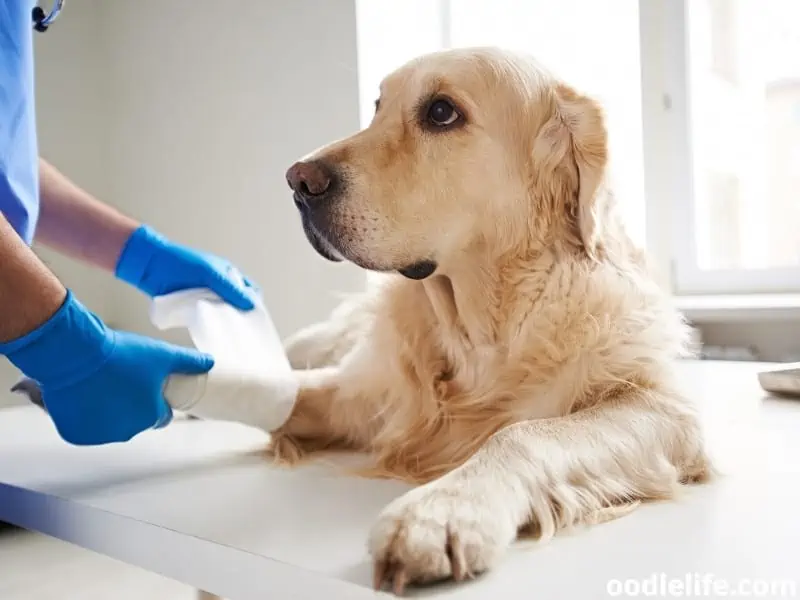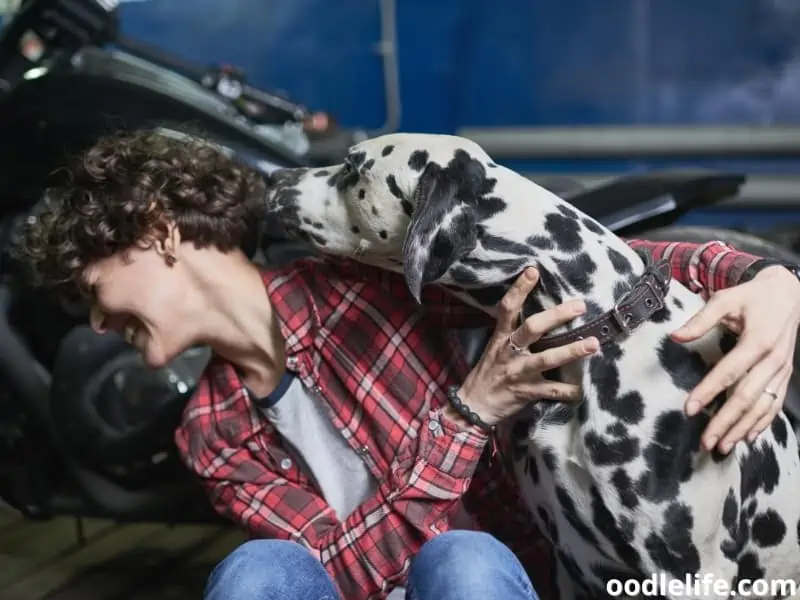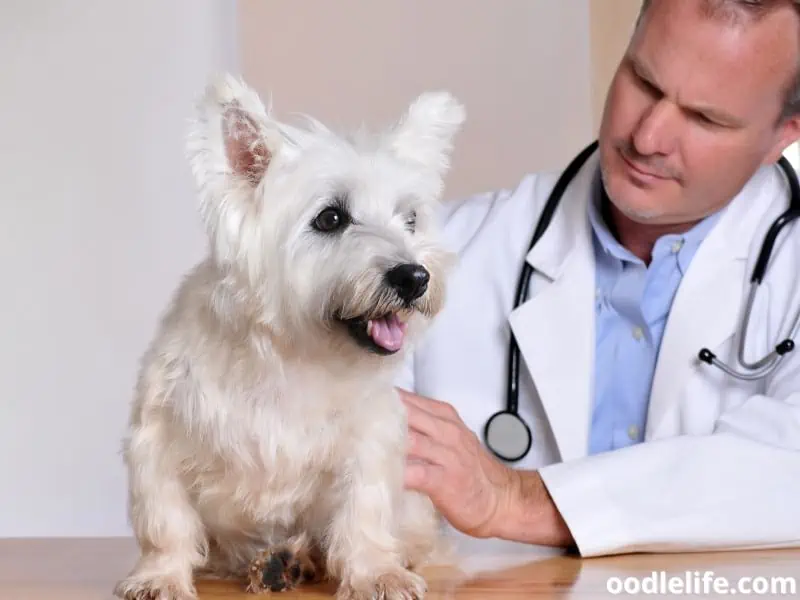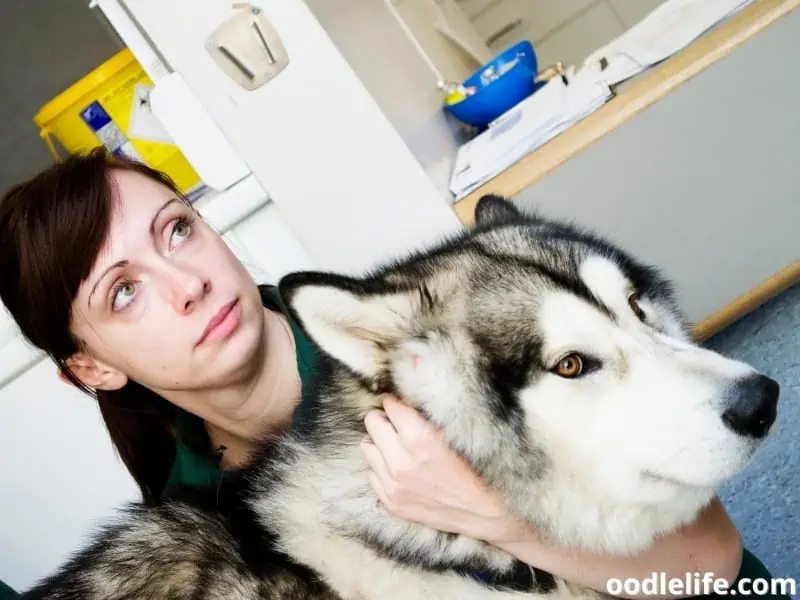Why a Dog’s Front Leg Will Shake? [Explained]
Dogs, our loyal and loving companions, can sometimes exhibit unusual behaviors that worry their owners. One such behavior is the shaking or trembling of a dog’s front leg. While it may be alarming, it’s important to understand that there are various reasons for this behavior, ranging from medical conditions to environmental factors.
Before jumping to conclusions, it’s crucial to pinpoint the cause of your dog’s shaking front leg, as the appropriate treatment or intervention will depend on it. Monitoring your dog’s overall health, their daily activities, and any changes in behavior will provide valuable information that can be discussed with a veterinarian.

With proper care and attention, a dog experiencing a shaking front leg can receive the treatment they need to maintain their health and happiness.
Key Takeaways
- A dog’s front leg shaking can be caused by several factors, including medical conditions and environmental issues.
- Proper diagnosis and treatment are essential for ensuring the health and well-being of a dog experiencing this issue.
- Regular monitoring of your dog’s health and behavior, along with ongoing preventive care, can help minimize the risk of leg shaking and other issues.
Common Causes of a Dog’s Front Leg Shaking
Injury and Pain
One common reason for a dog’s front leg shaking is injury or pain. Like humans, dogs can suffer from sprains, strains, or fractures, which can cause trembling or shaking as they try to cope with the discomfort. If your dog seems to be in pain or has recently experienced trauma, it’s a good idea to consult a veterinarian for treatment options and to rule out any serious issues.

A dog’s front leg could also shake due to muscle strains or overuse. For instance, if your dog is shaking after a long hike or intense game of fetch, it could be that their muscle is simply fatigued. Giving them some rest and relaxation might do the trick.
Stress and Anxiety
Stress and anxiety are pretty universal experiences, even for our canine pals. And just like with humans, stress and anxiety can manifest as some physical symptoms, like leg shaking. If you’ve managed to rule out any physical injuries or issues, it could be that your dog’s shaking leg is a sign they’re dealing with some emotional turbulence.

Keep an eye out for other symptoms, like excessive panting, hiding, or loss of appetite – all of which could indicate your dog is feeling stressed. Reducing possible stress factors and providing a safe and supportive environment for your furry friend can help alleviate the issue.
Cold and Hypothermia
Dogs aren’t immune to the effects of cold weather, and a shaking leg may be a sign that they’re feeling the chill. Hypothermia can set in if a dog’s body temperature drops too low, and shivering is a body’s attempt to generate heat. If your dog is shaking and you think they could be cold, try wrapping them up in a warm blanket or getting them into a more temperate environment.

It’s important to remember, though, that while some dogs are perfectly equipped to handle colder temperatures, others feel the cold more keenly. You wouldn’t want to send a Chihuahua on a dog sled race, would you?
Medical Conditions
Though rarer, some medical conditions can also cause dogs’ front legs to shake. For example, canine hypoglycemia, which occurs when a dog’s blood sugar is too low, can result in tremors. Various neurological and muscular disorders could also be at play.

If you suspect your dog’s leg shaking may be a result of a medical condition, consult your veterinarian for a thorough examination and diagnosis. Remember – you know your dog better than anyone else, so trust your instincts when it comes to their health and happiness.
Medical Conditions Related to Leg Shaking

Arthritis and Joint Infections
Some dogs might experience leg shaking due to arthritis or joint infections. These conditions can cause pain and discomfort, making it difficult for them to move their legs properly. For example, a dog with arthritis might shake its leg while trying to relieve some pressure from the affected joint.
If you suspect your dog is suffering from arthritis or a joint infection, it’s essential to consult a veterinarian for proper diagnosis and treatment.
Neurological Disorders
Leg shaking in dogs might also result from neurological disorders, such as seizures or distemper. These issues can have a direct impact on the nervous system, causing involuntary leg movements or tremors. For example, a dog experiencing a seizure might suddenly develop a shaky front leg.
Consulting a veterinarian is crucial for diagnosing and managing neurological disorders in dogs, as they’ll be able to prescribe appropriate medications and provide expert advice on the proper course of action.
Metabolic Imbalances
Metabolic imbalances, like hypoglycemia or kidney disease, can also cause leg shaking in dogs. When a dog’s body has trouble regulating its sugar levels or filtering out waste products, it can lead to muscle tremors and other symptoms. For instance, a dog with hypoglycemia might experience dizziness, loss of coordination, and leg shaking.
In cases like these, it’s essential to contact a vet as soon as possible to determine the cause of the shaking and initiate proper treatment.
Infections and Illnesses
Lastly, various infections and illnesses can lead to leg shaking in dogs. These can range from mild dehydration to more severe conditions, such as Lyme disease. For example, a dog with a mild fever or dehydration might shake its legs due to weakness and discomfort.
Again, consulting a veterinarian is crucial for identifying any underlying issues and providing appropriate treatment.
Remember, leg shaking in dogs may have several causes, and it’s essential to consult a veterinarian if you notice any unusual symptoms or behaviors in your furry friend. After all, our pets can’t tell us what’s wrong – it’s up to us to advocate for their well-being!
Behavioral and Environmental Factors
Fear and Nervousness
Sometimes, when dogs experience fear or nervousness, they might shake their front legs as a response. This could be due to a new environment, loud noises, or unfamiliar animals and people. For example, if you suddenly turn on a vacuum cleaner near your dog, the sudden noise might cause them to shake as part of their fear response.

Similarly, meeting a new dog at the park can be a nerve-racking experience for some pups, causing their front legs to quiver.
Excitement and Attention Seeking
On a lighter note, our canine companions may also shake their front legs when they’re excited or seeking attention. Picture this: you’ve been away all day, and as soon as you walk through the door, your dog gets so excited their front legs seem to have a dance of their own. This behavior can also be their way of asking for a treat, a belly rub, or simply because they’ve been trained to “shake a paw” as a cute trick.

Exercise and Overstimulation
It’s not just emotions that can cause our dogs’ front legs to shake, but also physical factors such as exercise and overstimulation. A vigorous play session or an extended walk might cause the leg muscles to work overtime, leading to some temporary shaking. For example, let’s say your dog just had an intense game of fetch and now they’re quivering with energy during their cool-down process.

It’s important to keep an eye on your pup’s exercise regimen and ensure they aren’t overdoing it. A proper balance of mental and physical stimulation can help keep both their legs and minds steady.
Diagnosis and Treatment Options
Consultation with a Veterinarian
If your dog’s front leg is shaking, the first step should be to consult a veterinarian. They are the experts in dog health and will have the knowledge to diagnose the underlying issue. They will likely perform a physical examination, and may also do some tests like x-rays or blood work.

In some cases, your dog may be referred to a veterinary specialist, such as a neurologist or orthopedic surgeon, for further evaluation. Remember, diagnosing a dog’s medical issue isn’t a piece of kibble; it’s a complex process!
Medications and Therapies
Depending on the diagnosis, there are various medication and therapy options available to help alleviate the shaking in your dog’s front leg. For example, if your dog is diagnosed with arthritis, your vet may prescribe pain relievers and anti-inflammatory medications to help reduce discomfort. If the shaking is caused by a neurological issue such as a pinched nerve, therapies like physical therapy or even acupuncture might be recommended.

No magic wand, unfortunately, but modern medicine is pretty amazing!
Supportive Care
Supportive care involves addressing the symptoms and making your dog more comfortable while you wait for the primary treatment to take effect. For example, if your dog’s front leg shaking is due to pain, your vet might recommend supportive care such as cold or hot compresses, joint supplements, or even providing a more comfortable sleeping area for your dog (maybe with extra fluffy pillows!).

Home Remedies
Home remedies can be a good option to try alongside the treatments prescribed by your veterinarian. For example, if your dog’s front leg is shaking due to muscle strain, gentle massage might help alleviate some discomfort. Additionally, ensuring that your dog has a well-balanced diet and gets regular exercise can go a long way in promoting overall health, minimizing issues like leg shaking.

Remember, a happy dog is a healthy dog!
Just remember to keep your dog’s best interests in mind and always consult with your veterinarian before trying any new treatments or home remedies. Your furry friend is relying on you to put their best paw forward!
Prevention and Ongoing Care
When it comes to preventing a dog’s front leg from shaking, several factors can come into play. The following sub-sections provide practical tips for taking care of your canine companion in order to keep those shakes at bay.
Regular Veterinary Checkups
It’s essential to schedule regular veterinary checkups for your dog, similar to how we humans go for our annual physicals. An experienced veterinarian can diagnose any underlying health issues that might cause your dog’s leg to shake and recommend the appropriate treatment. By staying proactive with vet visits, you’re ensuring a long, healthy, and shake-free life for your four-legged friend.

Maintaining a Healthy Lifestyle
A dog’s overall health and well-being are crucial for preventing leg shaking. Provide your dog with a balanced diet that satisfies their nutritional needs and engage them in regular exercise to keep them fit.

As a responsible pet owner, you should ensure your dog gets:
- Daily walks to keep their muscles strong
- Time outdoors to explore and play
- Proper mental stimulation (puzzles and toys)
- Lots of love and attention for emotional wellbeing
Remember, a healthy dog is a happy dog—and most likely a leg shake-free dog!
Proper Training and Socialization
Training and socialization play a key role in minimizing stress and anxiety—a common cause of leg shaking in dogs.

Let’s consider a few examples:
Pet Store Adventure: Taking your dog to the pet store can be both a fun and educational experience. Navigating through the store’s aisles, they’ll encounter a variety of new scents, textures, and even other dogs. This kind of outing teaches your pup to adapt to new environments and experiences.
Puppy Playdates: Setting up playdates with other dogs can help with socialization and burn off some of that boundless youthful energy. Playing with other furry friends might even tire them out so much that they won’t have energy left to shake those legs.
These examples demonstrate that prevention and ongoing care are essential in keeping dogs’ legs from shaking. By attending regular vet checkups, maintaining a healthy lifestyle, and ensuring proper training and socialization, you can minimize the occurrence of this issue and keep your dog happy and healthy.
Conclusion
In studying the reasons behind a dog’s front leg shaking, it’s important to consider various factors such as stress, training, or physical sensations. Research suggests that dogs in stress may exhibit behaviors such as low posture, body shaking, and crouching. It’s also noteworthy that dogs trained with shock collars may show more instances of lifting their front paw during obedience work.
What we can deduce from the information is that a dog’s front leg shake might be a result of their emotional state or a learned response from specific training methods. Remember, every dog is different, so observing your furry friend closely and consulting with a veterinarian or a canine behaviorist is always a good idea when concerned about your pet’s well-being.
To make it relatable, imagine you’re watching a movie and feel a sudden shiver or goosebumps; the reason might be an emotional reaction to what you watched. Similarly, your canine companion might be experiencing an emotional response when their front leg shakes.
In conclusion, a dog’s front leg shake can be attributed to various factors like stress, training methods, or even physical sensations. Keep a close eye on your pooch and seek professional advice when necessary. After all, we want our furry family members to feel happy, relaxed, and healthy.
And who knows, maybe one day they’ll develop an impressive secret handshake just for you!
Frequently Asked Questions
What are common reasons for a dog’s front leg to tremble?
Dogs may experience leg trembles due to various reasons such as anxiety, pain, discomfort, or muscle weakness. Sometimes, it could be a sign of an underlying medical issue like arthritis, nerve damage, or neurological disorders. It’s essential to monitor your dog’s behavior and consult a veterinarian if the shaking persists or worsens.
Can age be a factor in a dog’s front leg shaking?
Yes, age can be a factor in a dog’s front leg shaking. As dogs get older, they become more prone to developing age-related health issues, such as arthritis, joint pain, and muscle weakness. These conditions can lead to trembling in their front legs and might require appropriate treatment for increased comfort.
How does exercise impact a dog’s leg shaking?
Exercise is essential for maintaining a dog’s overall health. However, overexertion or intense exercise may cause temporary leg shaking due to muscle fatigue. Maintaining a regular, age-appropriate exercise routine can help keep your dog’s muscles strong and reduce the likelihood of shaking.
Should I be concerned if my dog’s leg shakes while standing?
If your dog’s leg shakes while standing occasionally, it might not be a cause for concern. However, if the trembling is frequent, persistent, or accompanied by other symptoms like limping, pain, or decreased mobility, it’s essential to consult a veterinarian to determine the underlying cause and find appropriate treatment.
What are possible treatments for a dog’s shaking leg?
Treatments for a dog’s shaking leg may vary depending on the underlying cause. Possible treatments include medication for pain or inflammation, physical therapy, joint supplements, and weight management. In some cases, surgical intervention might be necessary.
It’s crucial to consult a veterinarian for accurate diagnosis and treatment options.
Is it normal for a dog to shake and limp at the same time?
While occasional shaking or limping may not be a cause for alarm, if your dog is both shaking and limping simultaneously, it could be indicative of an underlying issue like injury, joint pain, or nerve damage. In any case, it’s best to get your furry friend checked out by a vet to identify and address the root cause effectively.